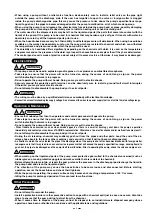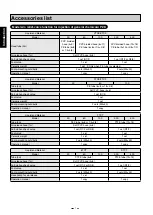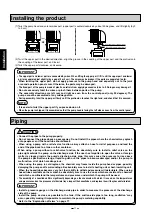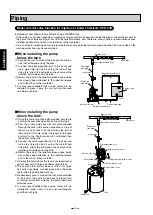
2
• When using a pump without a relief-valve function, be absolutely sure to install a relief valve on the pipe right
outside the pump on the discharge side. If the user has forgotten to open the valve or foreign matter is clogged
inside the pump’s discharge-side pipe, this may cause the pressure to rise above the pump’s specifications range,
liquid to gush out, the pipes to become damaged and/or the pump to malfunction, all of which are dangerous.
• When using the pump in cold regions, the chemical may freeze inside the pump head or pipes, possibly damaging
the pump and its surroundings. Be absolutely sure to install a heating unit or heat-insulating unit.
• The water used for the shipment tests may be left on the liquid-end parts (the parts that come into contact with the
liquid) of the pump. If the pump is to be used for chemical that may harden or give off gas if it reacts with water, be
absolutely sure to dry off the liquid-end parts prior to use.
• When the hoses/tubes become very hot, their ability to withstand pressure will deteriorate. When using hoses/tubes
available on the market, be absolutely sure to use the ones which are resistant to chemical and which can withstand
the temperatures and pressures under which the pump will be used.
• The durability of a hose/tube differs significantly depending on the chemicals with which it is used, on the temperatures
and pressures and on the presence of ultraviolet rays. Inspect the hoses/tubes, and replace them if they have deteriorated.
• The control panel cover is made of plastic so do not subject it to excessive force. Otherwise, it may break or be damaged.
Electrical Wiring
WARNING
!
• This pump cannot be used in explosion-proof regions or in explosive or combustible atmospheres.
• Take steps to ensure that the power will not be turned on during the course of work. Hang a sign on the power
switch indicating that work is in progress.
• Do not operate the pump with wet hands. Doing so may result in electric shocks.
• Securely ground the protective earth terminal, and be absolutely sure to install a ground fault circuit interrupter.
Otherwise, you may receive electric shocks.
• Do not attempt to disassemble the pump body or the circuit parts.
!
CAUTION
• The wiring must be done by a qualified electrician or somebody with electrical knowledge.
• Connect the wires after checking the supply voltage. Do not connect the wires to a power supply that is not within the rated voltage range.
Operation & Maintenance
WARNING
!
• Ensure that nobody other than the operators and control personnel will operate the pump.
• Take steps to ensure that the power will not be turned on during the course of work. Hang a sign on the power
switch indicating that work is in progress.
• Do not operate the pump with wet hands. Doing so may result in electric shocks.
• When trouble has occurred (such as when smoke appears or there is a smell of burning), shut down the pump’s operation
immediately, and contact your vender or a TACMINA representative. Otherwise, a fire, electric shocks and/or malfunctions may result.
• Do not attempt to disassemble the pump body or the circuit parts.
• During the air releasing, chemical may suddenly gush out from the pipes and other parts. Lead the end of the air-
release hose bank to the tank or other container, and secure it so that it will not become disconnected.
• A situation in which the valve inside the pipe at the discharge side of the pump is shut off or becomes blocked with foreign matter
is dangerous in that it may lead to an excessive rise in pressure that will exceed the pump’s specification range, causing liquid to
gush out, the pipe to be damaged and the pump itself to malfunction. Prior to operating the pump, check the valves and pipes, etc.
!
CAUTION
• When working on the liquid-end parts of the pump, wear protective gear suited to the chemical concerned (such as
rubber gloves, a mask, protective goggles and work overalls that are resistant to chemical).
• Before attempting to maintain or repair the pump, release the pressure in the discharge pipe, discharge the liquid in
the pump head, and clean the liquid-end parts.
• The vibration of the pump may cause the hoses/tubes to become loose and disconnected. Before starting
operation, secure the hoses/tubes and check their tightness.
• While the pump is operating, the pump’s surfaces may become hot, reaching a temperature of 60°C or more.
• Idling the pump for prolonged periods of time can lead to malfunctions.
Other Precautions
!
CAUTION
• Do not attempt to remodel the pump.
• Install a protective barrier or other preventive action to cope with a chemical spill just in case one occurs. Also take
steps to ensure that the pump will not get wet from the chemical.
• When it comes time to dispose of the pump, entrust its disposal to an industrial waste disposal company whose
operations have been authorized in accordance with applicable laws and regulations.
01-08̲PZD総合取説̲E.indd 2
01-08̲PZD総合取説̲E.indd 2
2010/07/22 18:22:58
2010/07/22 18:22:58




































